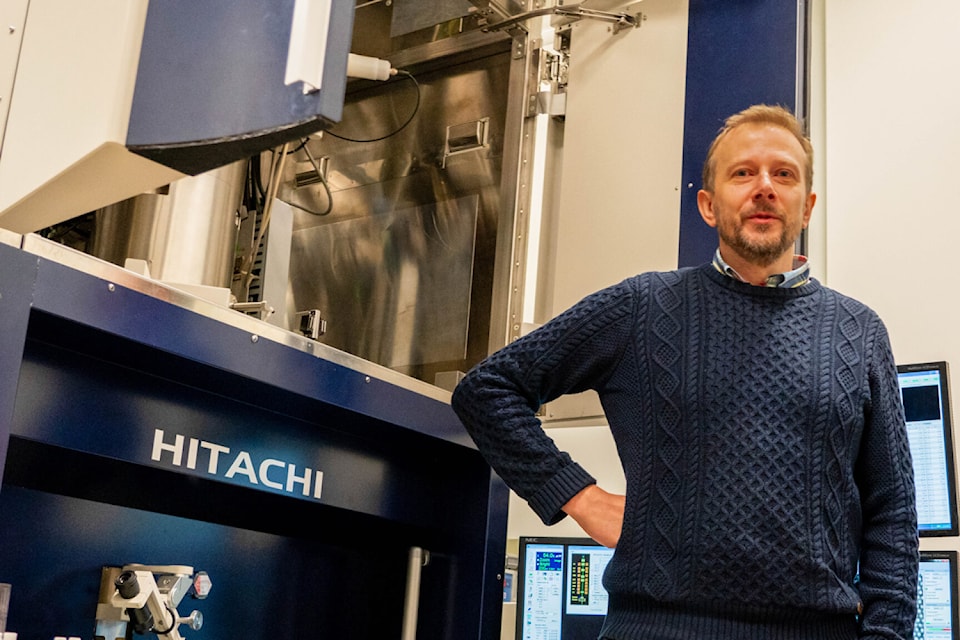Science
University of Victoria Achieves Breakthrough in Electron Microscopy

Researchers at the University of Victoria have made a significant advancement in the field of electron microscopy, enabling scientists to visualize atomic-scale structures with greater accessibility. This breakthrough, led by Arthur Blackburn, co-director of the university’s Advanced Microscopy Facility, involves a novel imaging technique that achieves sub-Ångström resolution using a compact and low-energy scanning electron microscope (SEM).
Traditionally, such high-resolution imaging required large and expensive transmission electron microscopes (TEM). The new technique demonstrates that high-quality imaging does not necessarily depend on costly equipment. Blackburn, who holds the position of Hitachi High-Tech Canada Research Chair in Advanced Electron Microscopy, emphasized the importance of this development, stating, “We’ve demonstrated that a relatively simple SEM, when paired with advanced computational techniques, can achieve a resolution that rivals or even surpasses traditional methods.”
Revolutionizing Microscopy
The findings were published in Nature Communications, marking a crucial step toward more accessible microscopy for laboratories globally. The innovative imaging method utilizes overlapping patterns of scattered electrons to create highly detailed images of samples. This approach allowed the research team to reach an impressive resolution of just 0.67 Ångström, which is less than the size of an atom and one-tenth the width of a human hair.
This breakthrough has the potential to transform various fields, including materials science, nanotechnology, and structural biology. Blackburn noted that the immediate benefits could be seen in the research and production of 2D materials, which hold promise for the development of next-generation electronics. In the long term, this advancement could also aid in determining the structures of small proteins, facilitating progress in health and disease research.
The implications of this research extend beyond technical specifications. By lowering the cost, space requirements, and personnel needed for high-resolution imaging, the technique encourages broader participation in cutting-edge scientific endeavors. This could democratize access to advanced microscopy, fostering innovation and collaboration across various scientific disciplines.
In summary, this achievement by the University of Victoria represents a pivotal moment in microscopy, with the potential to reshape how scientists study and understand the atomic world.
-

 Education3 months ago
Education3 months agoBrandon University’s Failed $5 Million Project Sparks Oversight Review
-

 Science4 months ago
Science4 months agoMicrosoft Confirms U.S. Law Overrules Canadian Data Sovereignty
-

 Lifestyle3 months ago
Lifestyle3 months agoWinnipeg Celebrates Culinary Creativity During Le Burger Week 2025
-

 Health4 months ago
Health4 months agoMontreal’s Groupe Marcelle Leads Canadian Cosmetic Industry Growth
-

 Technology3 months ago
Technology3 months agoDragon Ball: Sparking! Zero Launching on Switch and Switch 2 This November
-

 Science4 months ago
Science4 months agoTech Innovator Amandipp Singh Transforms Hiring for Disabled
-

 Education3 months ago
Education3 months agoRed River College Launches New Programs to Address Industry Needs
-

 Technology4 months ago
Technology4 months agoGoogle Pixel 10 Pro Fold Specs Unveiled Ahead of Launch
-

 Business3 months ago
Business3 months agoRocket Lab Reports Strong Q2 2025 Revenue Growth and Future Plans
-

 Technology2 months ago
Technology2 months agoDiscord Faces Serious Security Breach Affecting Millions
-

 Education3 months ago
Education3 months agoAlberta Teachers’ Strike: Potential Impacts on Students and Families
-

 Science3 months ago
Science3 months agoChina’s Wukong Spacesuit Sets New Standard for AI in Space
-

 Education3 months ago
Education3 months agoNew SĆIȺNEW̱ SṮEȽIṮḴEȽ Elementary Opens in Langford for 2025/2026 Year
-

 Technology4 months ago
Technology4 months agoWorld of Warcraft Players Buzz Over 19-Quest Bee Challenge
-

 Business4 months ago
Business4 months agoNew Estimates Reveal ChatGPT-5 Energy Use Could Soar
-

 Business3 months ago
Business3 months agoDawson City Residents Rally Around Buy Canadian Movement
-

 Technology2 months ago
Technology2 months agoHuawei MatePad 12X Redefines Tablet Experience for Professionals
-

 Business3 months ago
Business3 months agoBNA Brewing to Open New Bowling Alley in Downtown Penticton
-

 Technology4 months ago
Technology4 months agoFuture Entertainment Launches DDoD with Gameplay Trailer Showcase
-

 Technology4 months ago
Technology4 months agoGlobal Launch of Ragnarok M: Classic Set for September 3, 2025
-

 Technology4 months ago
Technology4 months agoInnovative 140W GaN Travel Adapter Combines Power and Convenience
-

 Science4 months ago
Science4 months agoXi Labs Innovates with New AI Operating System Set for 2025 Launch
-

 Top Stories2 months ago
Top Stories2 months agoBlue Jays Shift José Berríos to Bullpen Ahead of Playoffs
-

 Technology4 months ago
Technology4 months agoNew IDR01 Smart Ring Offers Advanced Sports Tracking for $169










